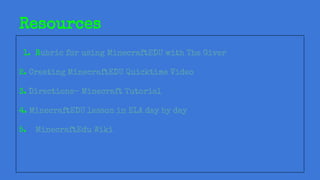EDSUMMIT Minecraft
- 1. MinecraftEDU for Assessment in ELA Lisa Waxman & Erin Zaich @lasdk8 Twitter @lwaxman
- 2. Closing Turn to a neighbor and discuss one way you might be able to use Minecraft to support literature. Post here
- 3. Resources 1. Rubric for using MinecraftEDU with The Giver 2. Creating MinecraftEDU Quicktime Video 3. Directions- Minecraft Tutorial 4. MinecraftEDU lesson in ELA day by day 5. MinecraftEdu Wiki
- 4. Step 2: Support Accessibility to MinecraftEDU? Find support for implementation if possible
- 5. Step 3: Purpose What do you want students to be able to do? Do you want them to understand characters? the setting? The interaction between character and setting?
- 6. Step 4: Evaluate Experience Evaluate student experience Assign mixed-ability pairs to complete MinecraftEDU tutorial
- 7. Step 5: Establish norms Ask students about tutorial experience What happened? What were the challenges? With students, create a list of class norms and consequences for use of MinecraftEDU
- 8. Step 6: Gather Textual Evidence Assign pairs a significant structure from the setting to study closely while reading. As students read, have pairs gather details about the assigned structure (patrons, location, purpose, appearance) using a shared Google Doc.
- 9. Prepare to Build Have class sketch out a map of the setting before beginning to build in Minecraft start to create their structure in a MinecraftEDU âflatâ world. Teacher creates a âflatâ world for each class wit one identifiable landmark from the literature that students can recognize.
- 10. Step 7: Build Give students time (I used 2 days a week over 4 weeks) to build structures. Students place information blocks on the inside and outside structure to justify their design using evidence from the text.
- 11. Step 8: Script Students play the role of a character interacting with the Minecraft environment. Students write a script that includes evidence from the text.
- 12. Step 9: Quicktime After rehearsing, each student creates a Quicktime video as the character interacting with the environment. Students are evaluated on the authenticity of their design and character tour compared to the text.
- 13. Step 10: Assessment Based upon authenticity of the character & design demonstrated in video Based upon essay (with textual evidence) included in the info blocks Self-assessment Class vote on âmost authentic worldâ with justification
- 14. Info Blocks Students type the justification of their design using info blocks in front of their structures
- 15. Example















